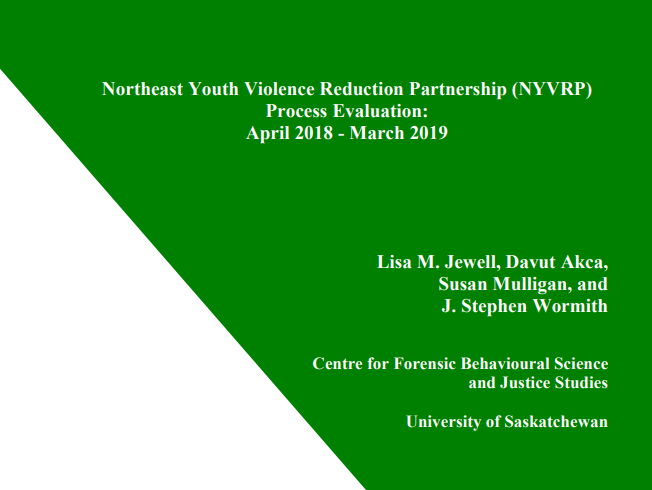
Northeast Youth Violence Reduction Partnership (NYVRP) Process Evaluation: April 2018 - March 2019
The current report focuses on the results of the process evaluation, which covers the time period of April 1, 2018 to March 31, 2019. A formative evaluation was previously completed (see Jewell, Mulligan, & Wormith, 2019) and spanned the first three years of the program (April 1, 2015 to March 31, 2017).
By Lisa M. Jewell, Davut Akca, Susan Mulligan, and J. Stephen WormithThe Northeast Youth Violence Reduction Partnership (NYVRP) is a five-year initiative (April, 2015 to March, 2020) that involves the delivery of programs and services to youth in three predominantly First Nation communities (Deschambault Lake, Pelican Narrows, and Sandy Bay). The purpose of the initiative is to reduce youth offending and create safer communities. As such, it targets youth who are 12 to 24 years of age, “at risk” or already involved in the criminal justice system, who exhibit violent behaviour, and/or who are gang-involved or at risk of gang involvement. The Saskatchewan Ministry of Justice, Corrections and Policing was awarded up to $4.5 million from the National Crime Prevention Strategy (NCPS) to implement the project.
The University of Saskatchewan’s Centre for Forensic Behavioural Science and Justice Studies has been contracted by the Saskatchewan Ministry of Justice to complete a formative, process, and impact evaluation of the NYVRP. The current report focuses on the results of the process evaluation, which covers the time period of April 1, 2018 to March 31, 2019. A formative evaluation was previously completed (see Jewell, Mulligan, & Wormith, 2019) and spanned the first three years of the program (April 1, 2015 to March 31, 2017). A second process evaluation, combined with an impact evaluation, will be completed during the final year of the program (April 1, 2019 to March 31, 2020).
Project Description
The NYVRP is informed by two theoretical models: 1) the Youth Violence Reduction Partnership (YVRP) model; and 2) the Re-Entry and Intensive Aftercare (RIAP) model (also referred to as the Community Connections Program in Saskatchewan). It is governed by an overarching Oversight Committee and local Advisory Committees and receives additional support and direction from the Saskatchewan Ministry of Justice. The NYVRP has a small staffing complement. At the beginning of this reporting period, staff included:
- 1 Project Manager, responsible for managing program development and delivery.
- 1 Manager of Program Operations (MOPO), formerly called the Health and Wellness Coordinator (HAWC), responsible for providing clinical oversight.
- 6 Health and Wellness Workers (HAWWs), two in each community, responsible for directly supporting youth enrolled in the program.
In January 2019, the Project Manager left her position. The program opted not to fill this position, leaving the staffing complement as 1 MOPO and 6 HAWWs.
HAWWs work with Core Teams in each community to develop and monitor care plans through an integrated case management process. HAWWs attempt to address youth’s risk factors by connecting them with appropriate supports and services and meeting with them on a regular basis (at least three times per week). HAWWs have a caseload of up to 7 to 8 youth each and work with youth for up to 18 months. The NYVRP is a voluntary program.
Program Evaluation
The current report focuses primarily on the results of the process evaluation, which spanned the fourth year of the initiative. Some of the key areas assessed by the evaluation were the:
- Adaptations made to the YVRP and RIAP models for the NYVRP in 2018-19
- Functioning of the governance structure
- Adequacy of staffing levels and training for staff
- Extent to which the NYVRP adheres to the principles of risk, need, and responsivity
- Characteristics of NYVRP participants
- Degree of adherence to the program delivery model
Data collection methods employed in the formative evaluation included:
- Document review of Performance Monitoring and Assessment reports (PMAs), meeting minutes, as well as program forms and materials
- Database review (i.e., Community Data Collection tracking sheet) of 84 individuals
- Casefile review of 73 individuals
- Observation
- Community Youth Survey with 100 participants across the three communities

